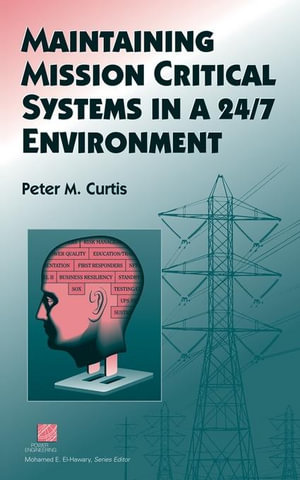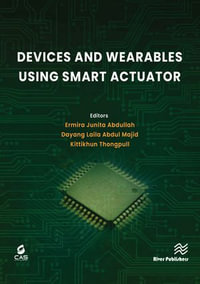
eTEXT
Maintaining Mission Critical Systems in a 24/7 Environment
By: Peter M. Curtis
eText | 13 April 2007 | Edition Number 1
At a Glance
eText
$162.79
or
Instant online reading in your Booktopia eTextbook Library *
Read online on
Desktop
Tablet
Mobile
Not downloadable to your eReader or an app
Why choose an eTextbook?
Instant Access *
Purchase and read your book immediately
Read Aloud
Listen and follow along as Bookshelf reads to you
Study Tools
Built-in study tools like highlights and more
* eTextbooks are not downloadable to your eReader or an app and can be accessed via web browsers only. You must be connected to the internet and have no technical issues with your device or browser that could prevent the eTextbook from operating.
The latest tested and proven strategies to maintain business resiliency and sustainability for our ever-growing global digital economy
Here is a comprehensive study of the fundamentals of mission critical systems, which are designed to maintain ultra-high reliability, availability, and resiliency of electrical, mechanical, and digital systems and eliminate costly downtime. Readers learn all the skills needed to design, fine tune, operate, and maintain mission critical equipment and systems. Practical in focus, the text helps readers configure and customize their designs to correspond to their organizations' unique needs and risk tolerance. Specific strategies are provided to deal with a wide range of contingencies from power failures to human error to fire. In addition, the author highlights measures that are mandated by policy and regulation.
The author of this text has worked in mission critical facilities engineering for more than twenty years, serving clients in banking, defense, utilities, energy, and education environments. His recommendations for maintaining essential operations are based on firsthand experience of what works and what does not.
Most chapters in this text concentrate on an individual component of the mission critical system, including standby generators, automatic transfer switches, uninterruptible power supplies, and fuel, fire, and battery systems. For each component, the author sets forth applications, available models, design choices, standard operating procedures, emergency action plans, maintenance procedures, and applicable codes and standards. Extensive use of photographs and diagrams illustrates how individual components and integrated systems work.
With the rapid growth of e-commerce and 24/7 business operations, mission critical systems have moved to the forefront of concerns among both private and public operations. Facilities engineers, senior administrators, and business continuity professionals involved in information technology and data center design should consult this text regularly to ensure they have done everything they can to protect and sustain their operations to reduce human error, equipment failures, and other critical events. Adapted from material the author has used in academic and professional training programs, this guide is also an ideal desktop reference and textbook.
Here is a comprehensive study of the fundamentals of mission critical systems, which are designed to maintain ultra-high reliability, availability, and resiliency of electrical, mechanical, and digital systems and eliminate costly downtime. Readers learn all the skills needed to design, fine tune, operate, and maintain mission critical equipment and systems. Practical in focus, the text helps readers configure and customize their designs to correspond to their organizations' unique needs and risk tolerance. Specific strategies are provided to deal with a wide range of contingencies from power failures to human error to fire. In addition, the author highlights measures that are mandated by policy and regulation.
The author of this text has worked in mission critical facilities engineering for more than twenty years, serving clients in banking, defense, utilities, energy, and education environments. His recommendations for maintaining essential operations are based on firsthand experience of what works and what does not.
Most chapters in this text concentrate on an individual component of the mission critical system, including standby generators, automatic transfer switches, uninterruptible power supplies, and fuel, fire, and battery systems. For each component, the author sets forth applications, available models, design choices, standard operating procedures, emergency action plans, maintenance procedures, and applicable codes and standards. Extensive use of photographs and diagrams illustrates how individual components and integrated systems work.
With the rapid growth of e-commerce and 24/7 business operations, mission critical systems have moved to the forefront of concerns among both private and public operations. Facilities engineers, senior administrators, and business continuity professionals involved in information technology and data center design should consult this text regularly to ensure they have done everything they can to protect and sustain their operations to reduce human error, equipment failures, and other critical events. Adapted from material the author has used in academic and professional training programs, this guide is also an ideal desktop reference and textbook.
Read online on
Desktop
Tablet
Mobile
ISBN: 9780470089033
ISBN-10: 0470089032
Published: 13th April 2007
Format: PDF
Language: English
Publisher: Wiley Professional Development (P&T)
Edition Number: 1























